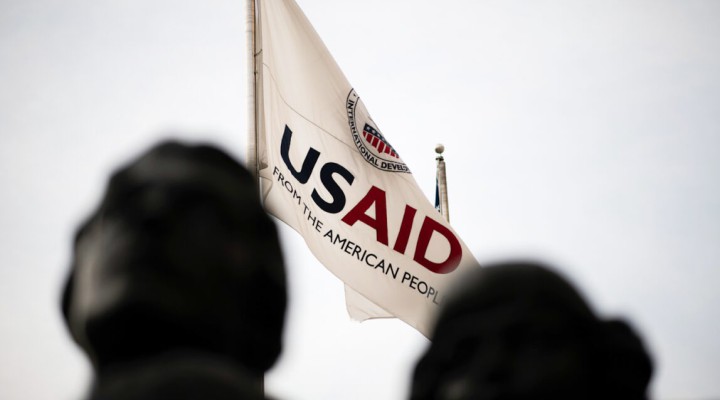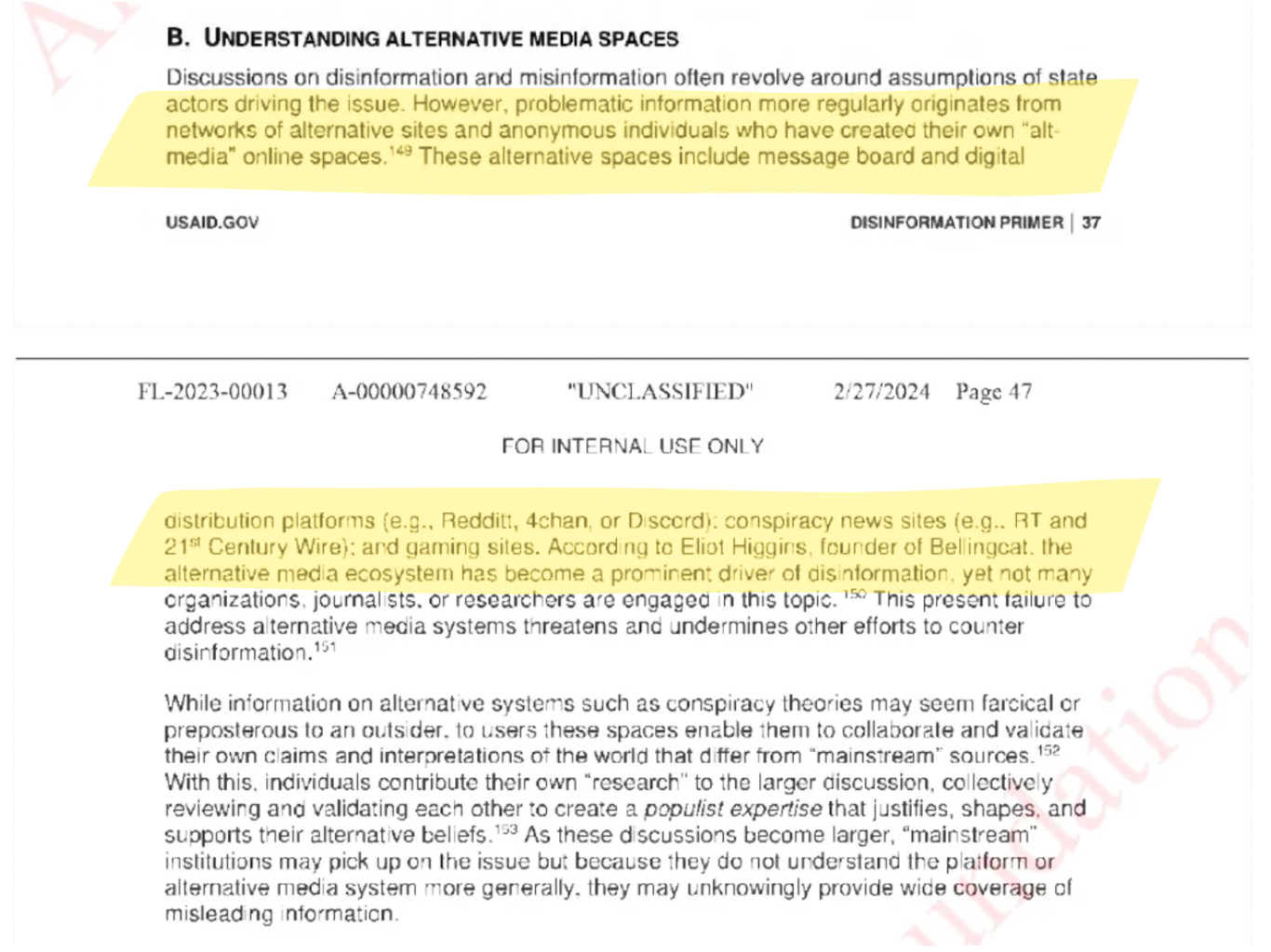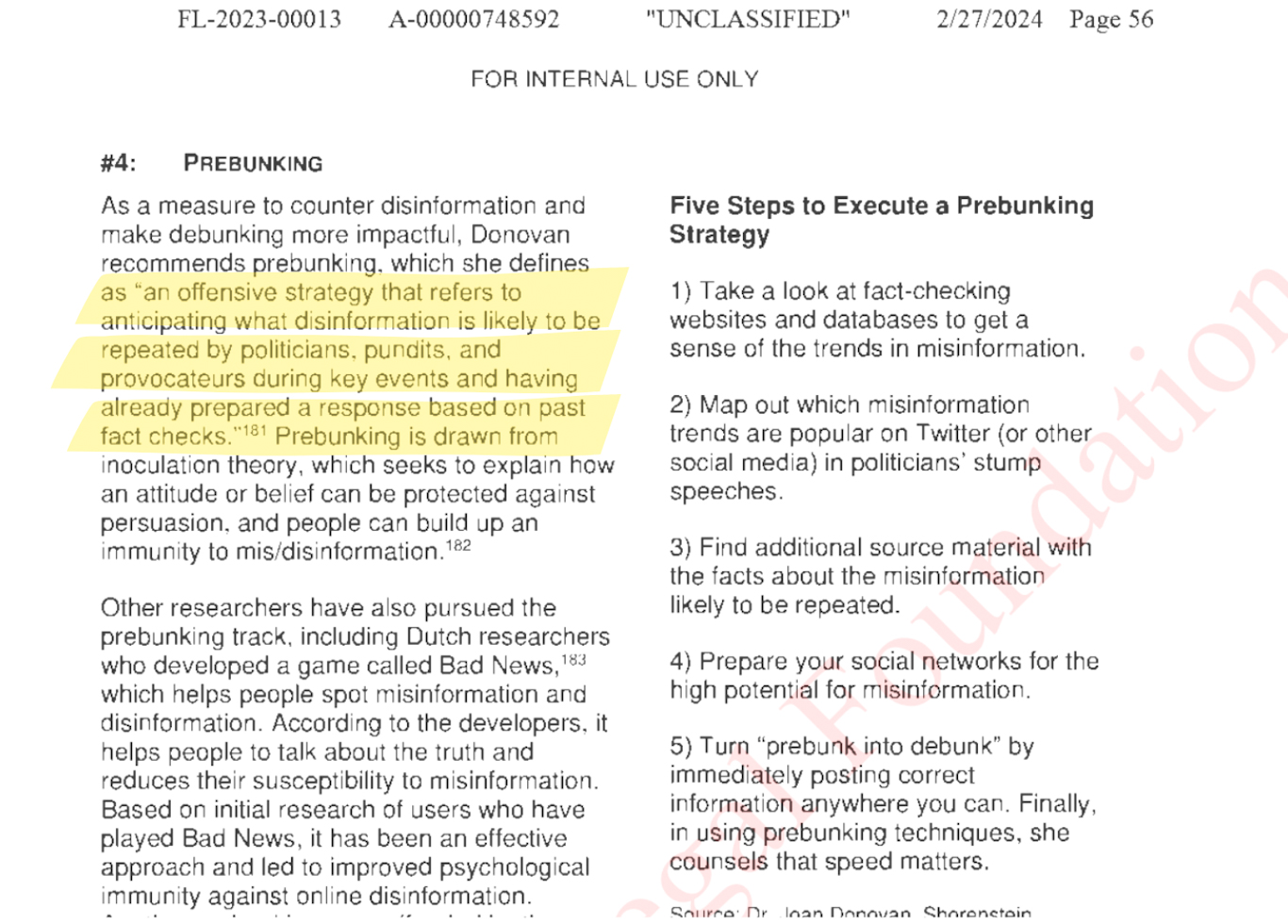USAID’s Disinformation Primer: Global Censorship in the Name of Democracy

Shocking revelations from a leaked USAID report expose how the agency collaborates with tech giants and media outlets to stifle free speech, silence dissent, and manipulate public opinion under the guise of fighting fake news.
A report from the United States Agency for International Development (USAID) outlines how the government agency has been encouraging governments, tech platforms, establishment media outlets and advertisers to work together to censor huge swaths of the Internet. The 97-page “disinformation primer,” obtained by conservative firm America First Legal under the Freedom of Information Act, purports to be fighting fake news. However, much of the organization’s focus appears to be on preventing individuals from finding information online that challenges official narratives and leads to increased questioning of the system more generally.
The document calls for regulating video games and online message boards, steering individuals away from alternative media and back towards more elite-friendly sites, and for governments to work with advertisers to cripple organizations that refuse to toe official lines financially. Furthermore, it highlights government-backed fact-checking groups like Bellingcat, Graphika, and the Atlantic Council as leaders in the fight against disinformation, despite the fact that those groups have close connections to the national security state, which is an overwhelming conflict of interest.
The news that a government agency is promoting such a program is worrying enough. However, we shall also see how USAID itself has promoted fake news to push for regime change abroad.
MISINFORMATION – AND INCONVENIENT FACTS
USAID’s primer identifies three kinds of information that it wishes to combat. In addition to misinformation (false information spread by those who believe it to be true) and disinformation (false information proliferated with intent to deceive), it states that “malinformation” is also a serious threat. Malinformation is speech that is factually correct but has been deemed misleading or taken out of context. Under this broad definition, any reporting or arguments, no matter their accuracy, could potentially be throttled online if it is deemed unhelpful or inconvenient to USAID and its interests.
While the report spends much time condemning enemy nations – particularly Russia and China – USAID appears much more concerned with clamping down on independent media and open spaces where alternative information and opinions can be found. As they write:
Discussions on disinformation and misinformation often revolve around assumptions of state actors driving the issue. However, problematic information more regularly originates from networks of alternative sites and anonymous individuals who have created their own ‘alt media’ online spaces.”
The report identifies platforms like Reddit, Discord and 4Chan as “conspiracy websites” that can help groups create “populist expertise” to develop alternative opinions and challenge official U.S. government narratives. These, alongside gaming websites, must be challenged and marginalized.

While wishing to stop disinformation is, in principle, a noble goal, the past decade has seen U.S. government agencies work hand-in-glove with Silicon Valley corporations to throttle the reach of alternative media that scrutinize and challenge their power and prop up establishment outlets that bolster Washington’s ambitions. All of this has been done under the banner of fighting fake news. MintPress News has been under constant attack from these groups, particularly since the 2016 election. This is hinted at in the report, which bemoans that “Because traditional information systems are failing, some opinion leaders are casting doubt on the media.”
RUINING THOSE WHO GO AGAINST US
Chief among the methods USAID outlines to suppress independent media is what it calls “advertiser outreach” – in effect, threatening advertisers into cutting ties with marginal or niche websites. “In order to disrupt the funding and financial incentive to disinform, attention has also turned to the advertising industry, particularly with online advertising,” the report explains. “Cutting this financial support found in the ad-tech space” would, it continues,
[O]bstruct disinformation actors from spreading messaging online. Efforts have been made to inform advertisers of their risks, such as the threat to brand safety by being placed next to objectionable content, through conducting research and assessments of online media content.”
Additionally, USAID states it hopes to “redirect funding to higher-quality news domains, improve regulatory and market environments, and support innovative and sustainable models for increasing revenues and reach.” In other words, it wants to use its power to move consumers away from alternative media and back into legacy news outlets that have seen a massive cratering in public trust precisely because viewers have been exposed to online content that highlights how poorly they cover the news. The report takes as a given that the establishment press are standard-bearers for truth rather than gigantic, multibillion-dollar international empires with long histories of publishing demonstrably false or biased stories.
Another recommended method is to “psychologically inoculate” the population, “prebunking” disinformation before it arises by predicting it and taking steps against it before it occurs. This might include “discrediting the brand, the credibility and reputation of those making false allegations” – a line that might suggest launching attacks against whomever USAID deems bad actors.
The report also suggests tracking users who view mis-, dis- or malinformation and redirecting them to curated YouTube videos debunking or arguing against those positions.

THE ELECTION THAT BROKE THE SYSTEM
The Internet and social media were not always the powerful political and social force they are today. But by the 2008 and 2012 elections, they had grown influential enough to prove decisive. Barack Obama’s team skillfully microtargeted voters on Facebook and other sites, helping him to two successive terms in the White House.
However, by 2016, the fallout from the 2008 financial crisis left tens of millions of Americans angry and desperate. Populist forces from both the left and the right arose to challenge the political consensus. While the Democrats were able to successfully neutralize any left-wing challengers, Donald Trump managed to take over the Republican Party and score an unlikely electoral victory despite virtually the entire establishment media endorsing his opponent.
Trump’s success alarmed the establishment in Washington, which quickly identified social and alternative media as the key driving force behind Trump’s victory. The Internet, they decided, was far too powerful to be left alone. It was no longer a fringe space but a major driving force in shaping public imagination and debate.
In the wake of the 2016 election, a huge campaign against the scourge of fake news was launched, as platforms like Google, Facebook and YouTube changed their algorithms in order to demote “marginal” content and promote authoritative sources. The upshot of this, however, was that high-quality alternative news sites saw their traffic decimated overnight, and establishment media like CNN and NBC News, which had been failing in the online arena, were promoted to the top of the search results.
One example of this was the case of PropOrNot, a shadowy group that claimed to have used sophisticated analytical software to identify hundreds of websites that were “routine peddlers of Russian propaganda.” Included on the list were WikiLeaks and (then) Trump-supporting websites like The Drudge Report, libertarian vehicles like Antiwar.com and The Ron Paul Institute, and a host of more left-aligned outlets such as Truthout and The Black Agenda Report. MintPress News was also included. Therefore, while PropOrNot’s list did include many fake news websites, it also represented a blacklist of dozens of sites critical of the establishment Beltway.
PropOrNot’s findings were heralded and signal-boosted the world over by establishment media, keen to see their rivals censored. The mounting pressure led Google and other platforms to drastically alter their algorithms to suppress alternative media. Almost overnight, MintPress News lost around 90% of its Google search traffic and over 99% of its reach on Facebook.
However, it was not just radical alternative media that were punished. Democracy Now! saw its Google search traffic fall by 36%, and The Intercept fell by 19%. Facebook CEO Mark Zuckerberg admitted in an interview that his platform intentionally throttled traffic to liberal news outlet Mother Jones explicitly because of its mildly left-of-center outlook.
It is now known that PropOrNot was not a neutral, independent organization but was very likely the creation of Michael Weiss, a nonresident senior fellow at NATO think tank the Atlantic Council. Thus, the whole hysteria about (foreign) government interference in elections was sparked by a quasi-governmental organization itself.
Since 2016, social media platforms have moved increasingly closer to the U.S. national security state. MintPress News investigations have uncovered how hundreds of former agents from the C.I.A., F.B.I. and the State Department now work in key positions at Facebook, Google, TikTok and Twitter, helping to shape those companies’ content policies. Some USAID officials have made the jump to social media as well. Mike Bradow, for example, left his job as deputy director of policy at USAID in 2020 to become a misinformation policy manager at Meta, the parent company of Facebook, Instagram and WhatsApp.
THE HOME OF COUPS AND DISINFORMATION
The revelations about how a government agency wishes to push such a radical censorship agenda are alarming enough. Worse still, USAID itself has a long track record of promoting disinformation in order to advance U.S. interests.
In 2021, the organization was behind an attempted Color Revolution (a pro-U.S. insurrection) in Cuba. USAID has long interfered in Cuban politics, devising a myriad of schemes, including infiltrating the country’s hip-hop scene and attempting to organize it as a revolutionary, anti-government force.
Eleven years earlier, USAID secretly created a Cuban social media app called Zunzuneo. None of the app’s tens of thousands of users were aware that the U.S. government had secretly designed and marketed it to them. The idea was to create a great service that would take over Cuba and slowly start feeding the population regime-change propaganda and directing them to protests and “smart mobs” aimed at triggering the overthrow of the government.
USAID was also intimately involved in the 2002 coup d’etat in Venezuela, which saw the temporary overthrow of democratically-elected president Hugo Chavez and his replacement with a pro-U.S. dictator. Since then, USAID has consistently attempted to subvert Venezuelan democracy, including by funding self-declared president Juan Guaidó. The organization was even at the center of a disastrous 2019 stunt where U.S.-backed figures attempted to drive trucks full of USAID “aid” into the country, only to light the cargo on fire themselves and blame the government. Few in Venezuela or abroad fell for their performance.
STRANGE FRIENDS AND WORRYING ENEMIES
The report sets its sights on gamers and online video games, calling for them to be regulated in the same manner as social media platforms. Extremists, they note, can spread false information on gaming platforms such as Twitch, which “enable users to coordinate to grow followers and spread content to large social media sites such as Facebook and Twitter.” “In this way, platforms that cater to very niche and small audiences have significant influence,” they explain.
It also warns that satire can be a major source of misinformation. While this is potentially true, the past decade has seen notable satirists that critique power and the status quo, such as Lee Camp, chased off multiple platforms, suggesting that certain types of satire might pique the ire of censors far more than others.
Perhaps almost as worrying as what USAID designates as problematic areas in need of regulation is whom it identifies as the “good guys” in the fight against false information. One of them is the Atlantic Council, the Defense Department-funded think tank with no fewer than seven former heads of the C.I.A. on its board. The Atlantic Council was founded as a NATO offshoot project and still acts as the organization’s intellectual headquarters. Yet USAID describes them simply as a “nonpartisan organization that galvanizes U.S. leadership and engagement in the world, with allies and partners, to shape solutions to global challenges,” lauding them for their “international work” and their “democratic defense against disinformation.”
Other groups identified as leading the fight against disinformation are Graphika and Bellingcat, two more groups that purport to be independent fact-checkers. However, as MintPress has previously detailed, they are quietly funded by the U.S. government and serve as mouthpieces for Washington, disseminating reports attacking official enemies and casting Western nations as leading the fight against misinformation.
In addition to this, the report mentions the German Marshall Fund’s Hamilton 2.0 dashboard as a useful tool, despite the fact that the previous Hamilton dashboard was very publicly exposed as useless in identifying Russian bots and fake information. As the Twitter Files revealed, Twitter/X’s former head of trust and safety, Yoel Roth, complained that the Hamilton dashboard caught barely any Russian bots and that virtually any conservative American, Canadian or British person was liable to be labeled as such. Roth dismissed the Hamilton dashboard as complete “bullshit.”
While the Hamilton dashboard was ineffective at identifying genuine sources of fake news, it certainly did provide some form of intellectual justification for suppressing large numbers of people who challenged the establishment status quo from social media. And that is a microcosm of the larger fact-checking and anti-fake news industry as a whole. Trust in media and public institutions, more generally, has been crumbling for decades. But the response from Washington has not been to attempt to win back the public’s support. Rather, it has attempted to stamp out any alternative ideas or means of communication in order to maintain its grip on power. The release of this report into the public domain and the revelations about how USAID understands misinformation and wishes to deal with it will likely do nothing to repair public confidence in the government. In fact, it is clear to see why they did not want this released in the first place.
Feature photo | An Agency for International Development flag flies in front of USAID headquarters in Washington, D.C. Graeme Sloan | Sipa via AP
 TheAltWorld
TheAltWorld 
Mihka'el Caron
Hi,
I just wanted to reach out and let you know that your content has been quite helpful for me.
My friends from Allthingsaustria recommended your site and I’ve not been disappointed at all
Cheers,
Mihkael Caron